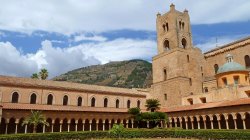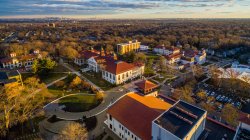NEH Supports Norman Conquest Project

For a century after the Norman Conquest of Sicily, the Italian island flourished. Sicily was at the height of its power in the 12th century, and even now, hundreds of monuments built in the era — from castles to monasteries — dot the Sicilian landscape. Now Montclair State researchers are looking to document and protect them.
Associate Professor of History Dawn Marie Hayes recently received a nearly $50,000 National Endowment for the Humanities (NEH) Humanities Collections and Reference Resources grant for an ongoing digital archival compilation of the Sicilian monuments for a project Hayes and her husband, Joe, a software engineer in the private sector, have been working on.
The one-year grant for the project, titled “Documenting the Past, Triaging the Present and Assessing the Future: A Prototype for Sicily’s Norman Heritage, ca. 1061-1194,” supports a pilot phase that will produce an online prototype that documents the 147 monasteries known to have been built during that era. The team will provide historical and site-specific data for all of the monasteries, as well as photographic and video documentation and relevant genealogical data for the 52 surviving structures. For historian Hayes, the project has special significance. “It’s important because it calls attention to a special society that was culturally rich — one where Christians, Muslims and Jews lived side by side in relative harmony over a century or so.”
According to Hayes, while the project is rooted in medieval history, it also draws on 21st-century STEM disciplines. “The Norman Sicily Project represents a society from almost a millennium ago via cutting-edge technologies that will be connected to other data sets on the web,” she says.
Earth and Environmental Studies Acting Chair Greg Pope is the project’s co-director and will guide the project’s sustainability component.
“We’ll enter information from field visits, seismic data and, whenever possible, results from on-site sustainability assessments of the conditions of the monuments’ stones and the greatest environmental threats to their survival,” Hayes explains. “We’re not just exploring these monuments as relics of a past age; we’re also assessing their ability to endure climactic, geologic, seismic and — in some cases — volcanic threats.”
